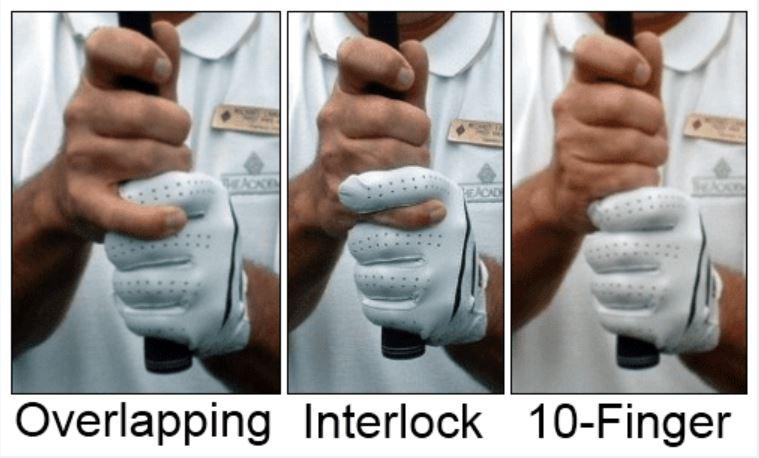
In simple terms, a golf grip is how you hold the golf club. It is your only physical contact with the club, directly influencing how the club head strikes the ball. A good grip ensures the clubface's proper alignment at impact, maximizes your club control, and increases the power and accuracy of your shots.
There are three main types of grips that golfers use: the overlapping grip, the interlocking grip, and the baseball or ten-finger grip. Please forgive me but these descriptions are based on right handed golfers. Please just reverse the hands if you are left handed.
a. Improved Stability: By placing your right pinkie between the index and middle finger of your left hand, you create a unified hold on the club, which can improve overall swing stability.
b. Better Club Control: This form of grip can enhance club control during the swing, allowing more precise shots.
c. Reduced Wrist Action: The overlapping grip tends to minimize excessive wrist action during the swing, which can lead to a more consistent swing plane and ball strike.
d. Comfort and Ease: Many golfers find the overlapping grip more comfortable, especially those with larger hands, since it can reduce tension and make the swing feel more natural.
e. Increased Power: With the hands working more as a unit rather than individually, swing power often increases, which can translate into increased distance.
a. Excellent for Smaller Hands: Golfers with smaller hands often find the interlocking grip more comfortable and easier to maintain than the overlapping or baseball grips.
b. Strength and Unity: This grip helps to create a strong bond between the two hands, promoting unity in the swing and potentially leading to more consistent shot-making.
c. Ideal for Beginners: The interlocking grip is a great starting point for beginners because it helps to ensure the hands work together during the swing.
d. Reduced Grip Pressure: Because of the locked fingers, golfers may feel more secure with the interlocking grip, leading to a tendency to apply less pressure. A softer grip can lead to better clubhead speed and more distance.
e. Helpful for Golfers with Less Hand Strength: This grip style can benefit golfers with less hand or forearm strength, like juniors and seniors, as it can help them maintain a firm grip throughout the swing without exerting excessive pressure.
a. Ease and Comfort: The ten-finger grip often feels more natural, especially to those new to the sport or transitioning from other sports like baseball. It's a simple, easy-to-learn grip that can provide comfort while developing other aspects of the golf swing.
b. Ideal for Players with Joint Problems or Less Strength: The ten-finger grip can help alleviate hand and finger stress. Dan often recommends this grip for players with arthritis, hand or finger injuries, or those with less hand and wrist strength.
c. Increased Swing Speed: By involving all ten fingers, the baseball grip can increase swing speed, resulting in potentially longer drives.
d. Better Club Control for Some Golfers: Some players, particularly those with smaller hands, find that the ten-finger grip provides better club control throughout the swing.
e. Flexibility for Hand Placement Adjustments: The ten-finger grip allows golfers to adjust hand placement and grip pressure to suit their swing characteristics better.
Regardless of the type of grip you choose, some principles hold true. Let's delve into a few critical aspects of a successful golf grip:
Having the proper grip doesn't guarantee a perfect swing, but it certainly enhances the chance of one. A grip that suits your style can help to correct slice or hook issues, increase shot distance, improve accuracy, and even prevent injury. While it may seem like a small detail, your grip can be a game-changer.
Mastering the golf grip requires practice, patience, and sometimes a bit of trial and error. Experiment with different types of grips and consider having Dan guide you through the process. Always remember, there's no one-size-fits-all solution in golf. What works best for your golf club pro might be dreadful for you.
A golf grip isn't just about holding the club; it's about controlling it, harnessing its power, and directing it precisely. The grip is where your game begins. Therefore, to truly unlock your golf potential, take time to understand and perfect your grip.